To get a great catch on a fishing trip, you should prepare well for it. This is about using the right inventory. This article will discuss how to choose an echo sounder. This is a device that will allow you to explore the bottom topography. This is a rather important moment when you need to choose a place for casting nets or other devices. This tool is able to show the fisherman both the fish and its size. It can be used to estimate the distance of the fish from the boat.
The tool will help you fish even in places that you have not yet explored. The echo sounder will allow you to look under the water and assess the current situation. This will be effective even in the case of winter fishing, when you need to choose an area under the wormwood.
Our article will allow you to understand how to choose a fish finder for fishing, having studied the technical specifications, so as not to buy a device that will later disappoint you in practice.
Content
- 1 What is an echo sounder?
- 2 List of the best fish finder manufacturers: which brand to choose
- 3 Sounder device and basic principles of operation
- 4 Sounder design
- 5 The main criteria for choosing an echo sounder
- 6 Additional options
- 7 Viewing Angle Features
- 8 GPS option
- 9 Case features
- 10 A variety of echo sounders
What is an echo sounder?
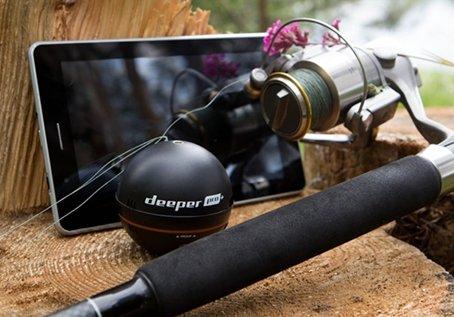
This tool will be useful in the need to find a fishing spot and fish out. He will not attract the catch, but he is able to solve these problems successfully. With the help of certain signals, he will notify the owner whether there is fish in this area or whether it is worth looking for a new one.
List of the best fish finder manufacturers: which brand to choose
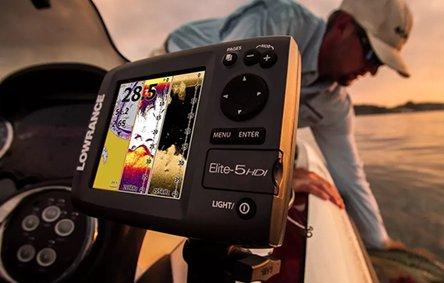
The best solution would be not just to study the parameters of the instrument, but to buy a quality device from an assortment of trusted brands. We are talking about such brands as: Garmin, Lowrance, Deeper, Praktik, Humminbird. Those who want more specific data are advised to study the TOP of the best echo sounders that will be appropriate for fishing at any time of the year. For self-selection of a tool, follow our article. We tried to fit in it a detailed description of the important parameters of echo sounders.
Sounder device and basic principles of operation
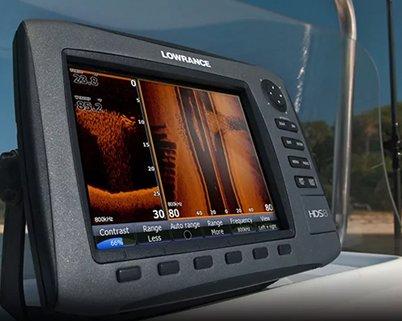
When thinking about which echo sounder to choose, you first need to understand what the principle of the instrument is. An echo sounder has been created as a navigation equipment that makes it possible to recognize the relief and underwater objects. It was used in the past only for military purposes, when it was necessary to understand where the enemy ships were located. But now the tool is ubiquitous and is successfully used in fishing, when traveling by water.
The main principle of the device is to create electrical impulses that become sound waves. They come from an emitter, which is placed at depth by connecting with a wire, or directly from the boat hull. There are also stand-alone models of the type of floats, which are presented using radio communication.
Due to the emitter, sound waves are emitted in different directions. Facing obstacles, they fight back and come back. This makes it possible to catch the connection with the receiver.Since the speed of sound in water is constant, you can calculate the milliseconds that have been passed and establish the exact location of the object. This device will do everything on its own based on the data that is embedded in it. The person will not need to count anything. A finished picture will appear on the monitor before his eyes.
Those. you will be able to see what the bottom topography is, whether there are sharp protrusions or depressions, how many fish there are under the boat and its size, and also what is the distance to the school area. To study the environment of the seabed, it was decided to use beams with different frequencies. The higher they are, the clearer the picture will be. For example, if the frequencies are lower, then the coverage area will be wider. The picture will be blurry due to interference.
Sounder design
Due to a number of key points it is possible to ensure the operation of the device. It is worth mentioning here: a case, a crystal for conversion and a transducer, as well as an antenna. There is a screen and special buttons for control, a battery and an emitter.
The picture will be displayed as a vertical scan, when the boat is standing, it is possible to study the depth and location of the fish. There is another mode, which is presented in the form of a horizontal scan, which demonstrates what is happening over a specified period of time.
The main criteria for choosing an echo sounder
The presence of rays: a quantitative parameter
There can be 1-6 beams in one echo sounder. It should be understood as a specific frequency of the signal that is sent by the sonar. The higher the frequency, the clearer the image will be, but narrower the capture area of the area.
If fishing is carried out from a PVC boat, where there is no motor, a single-beam echo sounder, which is designed for 83 kHz, will be sufficient.
When using an echo sounder on a large lake, you need 83/200 kHz for 2 beams. The indicator will allow you to see the overall picture and find out exactly what will happen under the bottom area.
If it is 3 beams, then the readings should be 83/200/800 kHz. They are sufficient for use at sea.
Even more 5-6 rays will be needed for fishing and hunting for a school of fish.
Screen size and quality characteristics
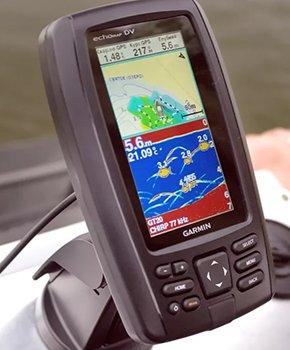
What happens at depth will be displayed on the monitor. Its dimensions can be 2-10 inches diagonally. There are screens, both black and white and color. The larger they are, the better the picture is available.
To assess the situation, it is enough to look at it with your own eyes and start acting. On a small screen, you need to zoom in on the image and drag parts of it in order to figure out whether this flock is represented on the monitor or just a very large individual in front of you.
In those situations when fishing is a simple interesting pastime for you, you can save a lot of money and get a device equipped with a black and white LCD display that is designed for 2 inches. Due to this, there is an idea of the relief, and you can also understand what the concentration of fish is and in what places.
The wider the bottom capture area, the more monitor is needed. If the beams are 83 and 200 kHz, then a screen of 3-4 inches is needed. In situations where shoals are being hunted at sea, look out for the large 7-10 "monitor to help you navigate quickly.
Calculation depth
Each device differs in such an indicator as the calculated depth. This distance is the maximum, from the surface to the bottom, which can allow sonar to explore the area of the boat hull.
If fishing is planned to be organized in a small reservoir, then a value of 25 meters will suffice, and in a lake with natural depressions and depressions - 35-80 meters.
When it comes to fishing on the high seas, the maximum figure is 365 meters. Such crevices are extremely rare for fishermen, but there are large fish in size. Therefore, you need to be prepared for such conditions as well.
Transmitter power ratings
Image clarity has several factors that affect it. One of them is the transmitter power.Since the sound emanates a long distance, reflected from objects, it easily returns back. Signal strength can affect quality. As for weak models, they easily get lost due to interference, and then give off errors.
Provided a small reservoir, a transmitter, which is designed for 150 W, is enough, but medium lakes - 200-300 W. Fishing at sea is capable of exploring long distances, and therefore a value of 500 W will be useful, provided that the peak is increased to 2400 W in an episodic manner.
Additional options
The choice of the device may depend on what additional plan options are present in it. They can be incredibly useful under certain conditions.
Determining the distance to the fish is a special parameter that will be useful if nets are established. It allows you to block the bay or the bait place in time.
Another option is to determine the size of the fish. It will appeal to those who hunt for certain species. For example, pike or big catfish. As a result, you can avoid wasting time on small representatives.
The temperature sensor makes it possible to show what is the number of degrees in an area of a certain depth. As a result, the user will personally figure out what temperature currents prevail in the area, whether it is necessary to stay there, or change the search by the zone. In cold water, the fish sinks to the bottom.
The speed sensor will tell you how fast the boat is moving. This is a useful option that will be useful for trolling lovers. It will allow you to understand whether the predatory fish will keep up with it.
Flasher. This option shows the sensitivity of the device. It makes it possible to see the tackle and fish that swim up to it. This will be practical if you are going fishing in the winter.
Viewing Angle Features
The range of application of the device can be estimated based on the characteristics of the viewing angle. If it is 20 degrees, then aiming "gaze" for casting the rod will be successful. At 45 degrees, you can take several fish into the coverage area, and therefore it will not be difficult to find a place for casting the wireframe tackle.
As for 90 degrees, it will be possible to cover the entire bottom surface. The indicator will help you find out the location of the jamb, as well as the place where it can be brought. For models with 2 beams, a combined scheme of exposure and capture of several viewing angles is calculated. Due to this, it will be possible to orientate the fisherman in the best way. But for fishing rods it is worth looking for models that are designed for 16/28 degrees, for nets - 20/60 degrees.
Screen resolution
Sonars also differ in resolution. The number of dots in the monitor, which determines the sharpness of the picture, allows you to see all the details. If the screen has weak pixels, then the school of fish will seem like a speck, but in a high-quality screen, every fish is present.
To fish with a line, it is better to choose monitors with a resolution of 240x240, or 240x270 pixels. This will give a complete picture of what the relief is and how many fish are available.
Fishing with a net or hunting for schools of fish needs full detail in order to correctly assess the situation. For this reason, monitors with 320x480, or 320x320 pixels are bought.
GPS option
This navigation is available in some echo sounder models. In addition to direct help, the element makes it possible to mark places on the map where there is a catfish or other other fish. Due to this, you can re-appear there with new tackle or bait. This is suitable for all those who prefer to fish in large open spaces.
Case features
The assembly of the device case must be of very high quality. As a rule, all models differ in exactly these properties. Today there are several options: IP x6 and IP x7.
As for the first case, it was allowed to get sea spray on the hull. Even if drops get inside, there will be nothing wrong with that. The device will be 100 percent serviceable.These models need to be attached to the boat so that they are away from the side surface.
Another option is the case, which protects the device in the event of a short-term fall into the water to a depth of 1 meter. This will be available in the case of using portable echo sounders, which can accidentally fall out of your hands when rolling or a gust of wind.
A variety of echo sounders
Stationary echo sounders
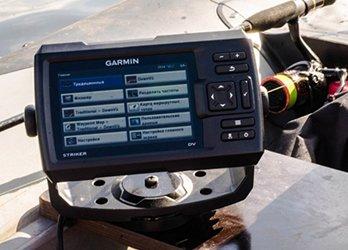
The device is mounted on the hull of a boat or a large boat. Used exclusively in the conditions of this vessel. The sensor can be located in the bow or the bottom of the vessel. Power supply is possible through a 12V network.
The body structure of stationary echo sounders is much larger, which makes it possible to endow them with various additional options and a screen for review. Models are used in sea conditions or lakes with a lot of space to keep track of schools even at speed.
Benefits
- power indicators are high;
- the image quality is not sufficient;
- a wide variety of beam switching in frequency;
- fish, size, relief and speed of movement are indicated;
- there is a log for depth and temperature;
- the assembly is of high quality;
- there is the ability to enlarge the picture.
disadvantages
- a 12V network is used;
- suitable for only one vessel, transferring to another is problematic if you need to do it quickly.
Portable echo sounders
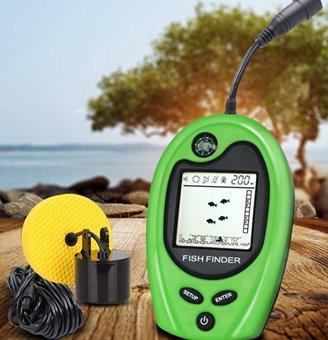
They differ in a small body. Such devices simply fit into a special case. The working process is carried out by a rechargeable battery or batteries. The dimensions are not large, which allows you to take the device in conditions of fishing on a boat, boat, and during winter fishing. The user will be able to take the structure with him when he will transport it from one vessel to another. Application is possible even if there is a bridge or a shore.
Benefits
- autonomy of functioning;
- accurate depth measurement;
- the case is protected from moisture ingress;
- compact size;
- the option to enlarge the picture is available;
- operation is simple;
- light weight;
- temperature sensor available;
- some patterns indicate the size of the fish.
disadvantages
- if the cord breaks, it will be difficult to find a small emitter;
- the screens of portable models are too small.



